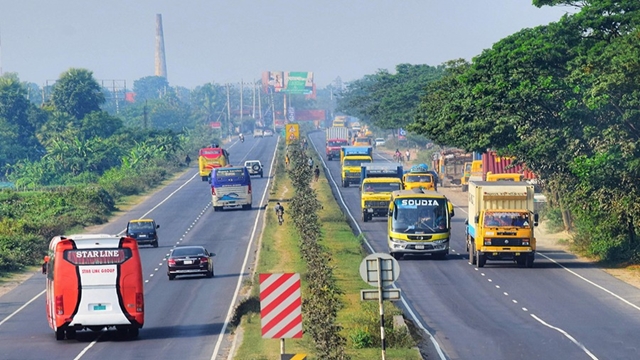FT Online
Published:2019-05-16 21:06:57 BdST
Cracks develop in 192km in two yrs
The country's prime Dhaka-Chattogram highway has turned bad cracks developed in almost 192 kilometres within two years into the completion of the four-lane work.
The run-down road has thus prompted the authorities concerned to embark on a costly maintenance project.
The Implementation, Monitoring and Evaluation Department (IMED) has spotted dilapidation along the median of the high-speed national highway.
It has also found faults and flaws on road surface and its layer while reviewing the four-lane project that completed in June 2017, sources said.
One year later in September 2018, Roads and Highways Department (RHD) sought Tk 9.83 billion from planning commission (PC) to make the artery operative for the next five years.
But the proposal has still been put on ice.
RHD officials said the PC has now proposed to cut costs to Tk 5.0 billion to carry out the work for four years.
Sources said the commission was not ready to approve the pricey maintenance project, rather questioning quality of the four-lane work.
A technical committee was later formed to see whether the road was refitted in sync with proper design.
It studied 60 points and submitted a report this March highlighting the need for essential repair work immediately, they added.
The Dhaka-Chittagong four-lane scheme was among the Sheikh Hasina administration's priority projects taken since she had come to power in 2009.
The corridor is the lifeline for economy having linked between the capital city of Dhaka and the port city of Chattogram.
But the RHD's project was undertaken without following a proper design, feasibility study and standards.
Twelve long years have been spent on this 193-km project to complete with a staggering Tk 38.16 billion.
It was earmarked at Tk 21.68 billion in the first approved development project proposal.
Over the years, it also got 12 project directors and went through design changes to overcome flaws.
The project also suffered a setback for picking a Chinese company as the lowest bidder even knowing the cost was much below the project's engineering cost.
Despite heavy traffic and its socio-economic importance, the highway lacks lanes for slow-moving vehicles, underpass or overpass.
Overruling allegations of faulty design or below-standard work, RHD officials, however, said maintenance fund was sought to increase its strength as overloading is the main reason of its dereliction.
The road experiences 90 per cent freights from Chattogram port which lies mostly overloaded, they argued.
Overloading causes rutting or permanent deformation in pavement layers or sub-grade.
According to the IMED report, the four-lane plan was first mooted in 2006 with standard axle load of 10 tonnes for two-axle or six-wheel trucks.
But from November 01, 2017, road transport and bridges ministry allowed 22 tonnes for two-axle vehicles, 30 tonnes for three-axle or 10-wheel vehicles.
The highest 44 tonnes were permitted to four-axle or 14-wheel vehicles with a minimum of Tk 2,000 in fines.
A corps of engineers and transport experts made strong reservations, but the ministry bowed to truck and covered van owners and workers associations.
"We've found 40-50 tonnes more load than the standard axle on this highway. Overloading by one tonne may damage much and a road cannot be sustainable for more than a year," said RHD chief engineer Ebne Alam Hasan.
According to RHD estimates, 50 per cent trucks and covered vans of grossly 28,000 vehicles ply the highway. The growth rate on the highway is 11 per cent.
The IMED study found 133 million equivalent single axle load (ESAL) in 2016 against 62 million at design stage.
The ESAL is calculated with the number of vehicles and overloading.
With 11 per cent traffic growth, the ESAL is to increase to 177 million in 2019.
The report also found design flaws as it is estimated only 6.0 per cent average traffic growth when RHD guideline at that time recommended it 10 per cent.
Mr Hasan, however, said despite all allegations and flaws, there is no denying that the country's prime and major highway could be operative.
"We've no option but to keep the corridor functional as freights on it are also rising for the port's increased handing capacity," he told the FE.
Both the technical panel and IMED highly recommended making axle control stations operative at the port so that overloaded vehicles do not ply the road.
Although the port has six axle control stations, they lie idle, according to RHD officials, for releasing containers with overloading and free space.
According to IMED data, loading and unloading capacity of Chattogram port rose to 73.44 per cent in 2017-18 from the 2013-14 level.
Currently, 99.52 per cent, which is 78.0 million TEU (twenty-foot equivalent unit), containers use the road.
Unauthorized use or reproduction of The Finance Today content for commercial purposes is strictly prohibited.


